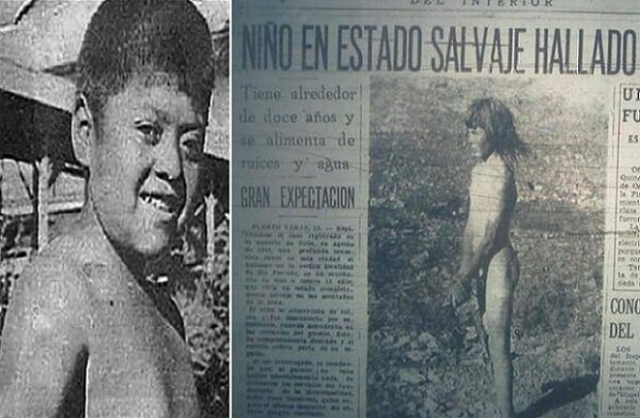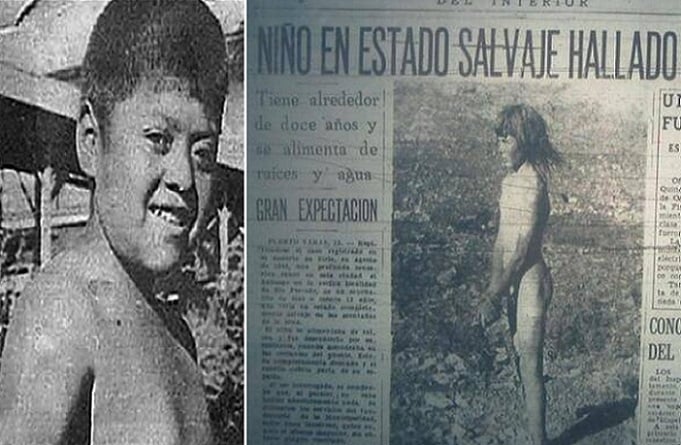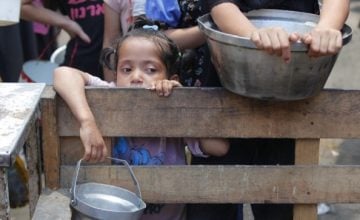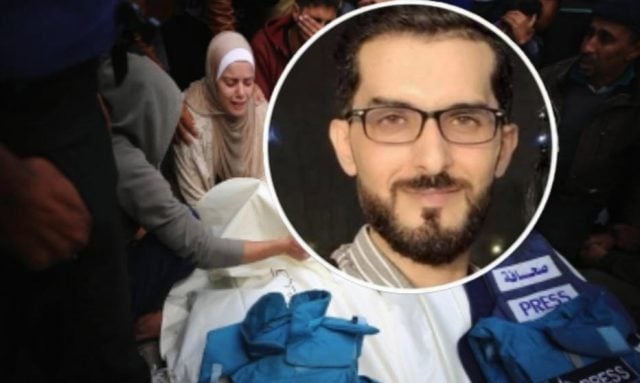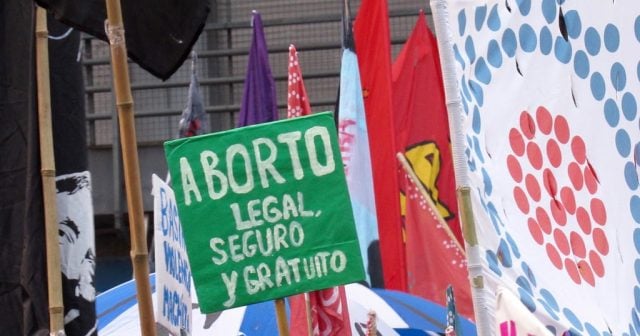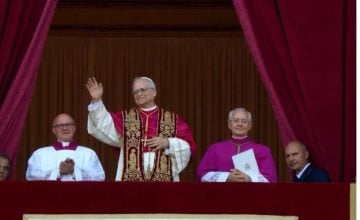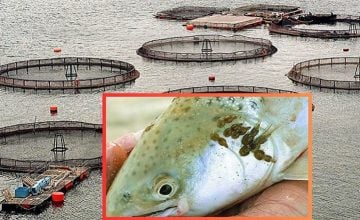On October 30, 2010, the so-called «wolf-boy» or «tarzan boy» left this world and his body rests in the Puchuncaví cemetery.
It was the year 1948 and in the south of Chile strange events were happening, an enigmatic being stole eggs, cheese or sugar in the houses of peasants who also discovered the udders of their cows with strange lesions. There were complaints, but the culprit was not found and it seemed strange that the person responsible was an animal.
Until the neighbors discovered that it was not an animal, but a small child, no more than 10 years old, who was found in the wild near Río Pescado, Ensenada, near Puerto Varas. The child was baptized as Vicente Cau Cau.
This was the true story that inspired the audiovisual project «Cau Cau and the pearl of Ngen-Ko» and motivated a group of prominent regional artists, from the circus and audiovisual area, to recreate this unknown history of the deep and enigmatic south.
The film will be released on April 3 at the Cine Club of the Austral University of Chile, in Valdivia.The filming
The project was financed by Mincap, through the Fund for the Promotion of Performing Arts, Creation and Production Line for the year 2021, and was carried out between June 2021 and March 2022.
The interpretation of the characters was in charge of Daniela Pérez, Cristian Provoste, Daniela González, Catalina Ibarra, Carla Sánchez and Camilo Cuevas. The audiovisual direction and editing proposal was in charge of Julio Lobos.
“The main aesthetic resource that defines the character in this work is the circus. The audiovisual language seeks to be a medium that enhances the vast expressive qualities of the circus as art, both in its technique and in the aesthetic treatment of the fantasy that surrounds the plot”, commented Julio Lobos to Diario de Osorno.
«The use of the optics, the lighting and collecting locations from the Valdivian jungle gave us the chance to make the most of the photography of the narrative universe that the script proposes», explained Lobos to the media.
The story of the «Tarzan Boy» who grew up in the forests of southern Chile
By Pablo Santiesteban
This is the true story of Vicente Caucau, who grew up wild in rural areas near Puerto Varas and returned to civilization when he was ten years old.
He walked on all fours, he had hair on his body and scars on his skin, he growled and when he felt threatened he bit or scratched, but he was not a wild animal.
This is how they found in Las Cascadas, near Puerto Varas, Vicente Caucau, a ten-year-old boy in a totally ‘savage’ state and that the press of the time baptized as the «Wolf Boy» or «Tarzan Boy».
In the middle of the 40s of the 20th century, the population of Las Cascadas was intrigued by a strange being that stole eggs, cheese or sugar from the houses of peasants, who found the udders of their cows with strange lesions.
There were complaints, but the culprit was not found and it seemed strange that an animal such as a fox or a puma did not attack the breeding birds but did take the eggs.
Superstition suggested that the person involved in the strange robberies was a fantastic being from the Chilote mythology, the imbunche, a deformed man associated with stories of witches and enchantments.
According to press reports at the time, it was Corporal José Fuentealba Solís, from the Río Pescado Carabineros checkpoint, who led the search for the animal along with locals and some dogs.
It was on August 10, 1948 that this group got a big surprise when they found this imbunche that moved on all fours. Someone tried to catch him and ‘the being’ bit him on the arm with impressive force, but he was finally caught.
The animal, the mythological being, was no more than a boy of about ten years old, with muscles developed for his age, long hair, and who did not utter a single clear sentence.
They immediately took him to the Río Pescado checkpoint to spend the night and the next day they transferred him to the public prison in Puerto Varas, but the boy once again escaped.
Hours later they found him and, according to what Corporal Fuentealba told the press, he was found swallowing raw fish near the Tepu River.
The boy spent seven days in the Puerto Varas jail and despite the fact that the news had been spread, no one came looking for him, which led to the assumption that he had no relatives.
He did not say words, although he pronounced, as a whisper, «caucau».
Domestication
The «Tarzan Boy» was taken to a hospice in Recoleta, Santiago, and there, some nuns took care of him. In that hospice they baptized him as Vicente Enrique de la Purísima.
Much of what is recounted about Vicente’s later life is based on the book «Chronicle of a Wolf Boy» published partly as an autobiography and partly as a novel by Cristian Vial, who met the protagonist of this story in person.
The nuns tried to teach him to speak and to recognize colors. They changed his eating habits and he learned to use cutlery.
But the person with whom Vicente achieved a special relationship was with Berta Riquelme, a teacher, a relative of one of the psychiatrists who studied the child’s case, Dr. Gustavo Vila.
Berta adopted him as if he were her own son and she began a teaching process, including doing housework.
However, his ‘wild side’ never left him and it was said that he had the ability to climb trees, a developed sense of smell and privileged night vision.Mom Bertha
According to what was compiled in publications by The Clinic and Publimetro and in a video from the En Presencia channel, uploaded to YouTube, Berta Riquelme took Vicente to Villa Alemana and there, the boy began, for the first time, to feel the life of a family and affection.
The teacher lived in a country house and Vicente spent hours enjoying his life in that place.
In less than a year, the boy had already shown progress in his vocabulary and was able to communicate better with his adoptive mother.
Using a language mixed with words and gestures, Vicente told her mother Berta –as he called her- what life was like for him in the southern forest and why he came to be there.
In a blog, Berta wrote that Vicente had told her that his biological mother was an alcoholic and she abandoned him when he was very young and that he lived with his father, also an alcoholic, and other siblings.
In 1953, the newspaper El Llanquihue of Puerto Montt found the whereabouts of Vicente’s father, a man named Antolín Caucau -the enigmatic word the boy whispered- and he reported that the boy’s real name was José Mercedes Caucau Barría and that he was lost when he was just four or five years old.
Perhaps the situation of abandonment of the child made him escape from what was his home and go into the forest, the amazing thing is that he managed to survive so many years without problems until he was found. How did he do it?Cougar boy
In that blog, Mama Berta recounted that Vicente confessed to her almost as if it were a dramatization that in the forest he met a puma, but instead of attacking him, she nursed him as if it were one of her cubs.
Perhaps that is why he got used to walking on all fours, increased his muscles and night vision, and acquired body hair. Perhaps Mother Nature gives talents to those who are best suited to her.
Later, during his life in Santiago, he would visit the Cerro San Cristóbal zoo and, according to what they say, he had a predilection for pumas that he could observe in silence for a long time.He went back South
In 1959, when Vicente was 21 years old, he suffered the most painful loss of his life, his mother Berta passed away.
According to Cristian Vila’s book, the impact was so great that the now young Caucau went to the cemetery every day to visit her grave. He had no notion of what death meant and every day he watered Mama Berta’s grave.
The psychiatrists had diagnosed that Vicente had the mental age of eight, so playing with children was the most natural thing in the world for him.
They came to the conclusion that during his birth, perhaps by caesarean section, when he was removed with forceps they damaged the frontal lobe of his brain, which would explain why his mental age remained at that of a child.
After Berta’s death, the young man went to live in the house of the psychiatrist Gustavo Vila and grew up with his children in their house in Ñuñoa.
According to The Clinic, in 1964 he decided to return to Puerto Varas, after a fight with the Vilas. It is said that the candidate for President of the Republic, Julio Durán, was at the airport and was being interviewed by the journalists, but when they recognized Vicente they left the politician and began to take pictures of him.Horcón
Vicente did not manage to last four days in Puerto Varas and returned with the Vilas. He soon found another place that was his fascination, the Horcón spa where his adoptive family spent their summers.
At first, people looked askance at this strange man who behaved like a child and when he had tantrums he scratched himself and tore his clothes. Little by little they accepted him.
When Dr. Vila died, Vicente escaped to Horcón and reached the business of the Caballería Rodríguez family, acquaintances of the Vilas, who ended up incorporating him into their life.
However, in the year 2000 a biological brother went looking for him in Horcón and took him away.
Four years later, Dr. Vila’s son, Cristian, received a phone call from the south. A woman who identified herself as Vicente’s sister explained to them that her brother, who had taken him from them, had died and that he had now lived with her for two months, but that she could not take care of him.
Vila asked to speak to Caucau and from the other side of the receiver he heard his voice: «Come find me». At that moment, he remembered his childhood with that big boy, cried for his «brother» and asked him to come back.
Thus, Vicente Caucau returned to the Caballería Rodríguez house and Vila organized a welcome barbecue for him.
But Vicente was no longer the same. He was an old man and his health had declined, he had stomach problems and suffered from hypertension.»Vincent is going to die»
One day, an old Vicente collapsed on the ground and the Caballería family ran towards him, scared, because they wanted to help him. Suddenly, Vicente sat up, laughing at his own joke. Amid laughter, he suddenly said “Vicente is going to die. Everyone mourns Vicente”. They kept an awkward silence, as if it were a prophecy.
On October 30, 2010, the ‘wolf-child’ left this world and his body rests in the Puchuncaví cemetery. Some time before his death, he himself had announced that this would be his last resting place and he even wallowed in the grave as if measuring that his body could enter it.
Cristian Vila wrote a novel entitled Crónicas de un niño-lobo (1999) where he recounts some passages from the life of Vicente Caucau, a story that unites the wild force of nature with the deepest side of what makes a human being.
In spanish:
